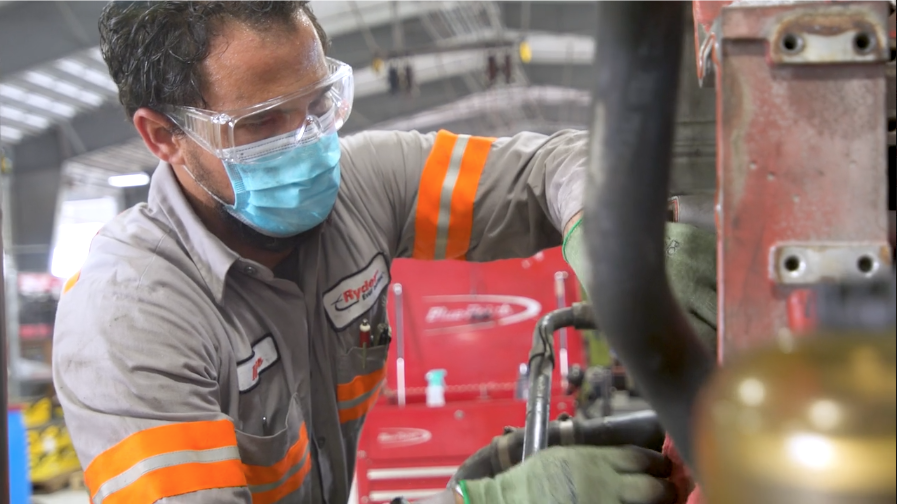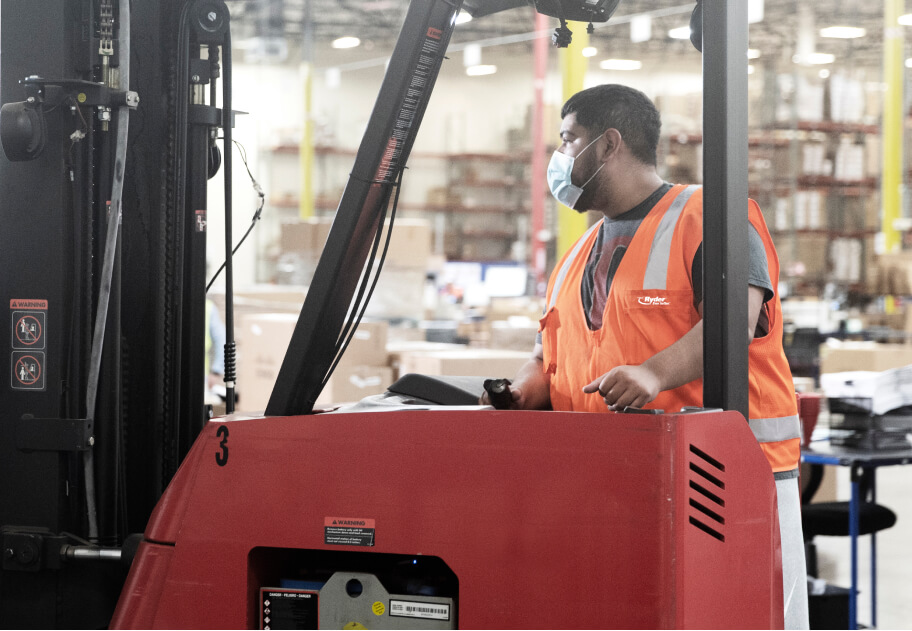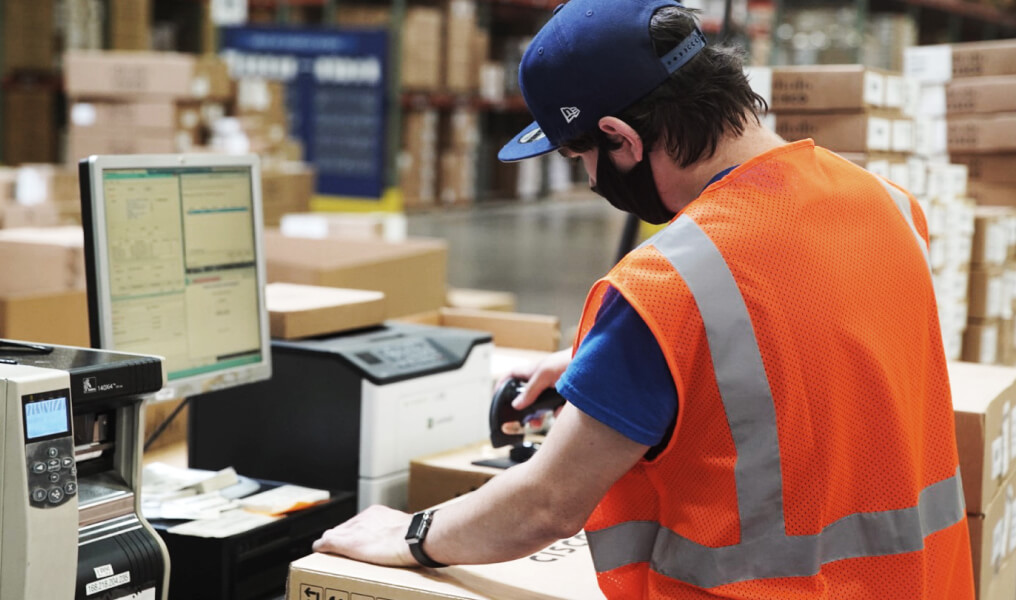SAFETY IS AN INTEGRAL PART OF OUR BUSINESS OPERATIONS
Safety is Ryder’s number one goal and motivator. It has to be. Preventing injuries and collisions improves employee quality of life, eliminates service disruptions for our customers, increases efficiency, and strengthens our brand reputation. Safety is imperative and translates throughout our business to our employees, customers, and communities. Ensuring our employees adhere to the strictest safety protocols at the workplace and on our shared roadways, not only keeps our employees safe, it makes our shared environments safer for the communities and customers we serve. Our steadfast commitment to the safety, health, and well-being of our employees, customers, and communities has made us a trusted industry leader, and with that dedication comes a responsibility to uphold and exceed the industry expectations placed upon us. Ryder employees put safety first and foremost in everything they do, whether at a customer location, at our facilities, or on the road.
Our Approach
Safety is a core element of our day-to-day operations, and employees at every level of the company share the responsibility and accountability for employee, customer, and community safety. We encourage all members of our workforce to contribute to the strengthening of our safety standards through continuous improvement initiatives. Our “Captain of the Ship” policy also empowers every employee to halt an operation if they feel a situation doesn’t meet Ryder’s rigorous safety standards without the delay of waiting for a manager to evaluate the situation and authorize a course correction. This policy is the foundation of our safety program and enables a culture where safety is every employee’s responsibility.
Our talented and dedicated Safety Organization team drives our overall safety strategy and consists of three divisions: Safety Standards & Technology, Field Safety Solutions, and U.S. Department of Transportation (DOT) Compliance. All three groups report to our Group Director of Safety and are responsible for promoting and enforcing Ryder’s safety culture.
Safety Standards & Technology Group
- Led by the Senior Director of Safety Standards & Technology.
- Manages safety policies, technologies, and training, in addition to having responsibility for all safety metrics, Safety Management Systems, and incident management.
FIELD SAFETY SOLUTIONS GROUP
- Led by two Field Safety Directors in Integrated Logistics and a Field Safety Director within Fleet Management Solutions.
- Oversees all field safety processes, risk assessments, management training, safety site investigations, and day-to-day safety support.
DOT COMPLIANCE GROUP
- Led by the Senior Manager for DOT Compliance.
- Oversees driver performance management and all regulatory compliance activities, supports operational locations and compliance case management. During monthly conference calls with key division points of contact, our Senior Manager for DOT Compliance trains managers and promotes compliance activity accountability.
The Senior Vice President responsible for the Safety Organization presents a quarterly Report on Safety to the Corporate Governance and Nominating Committee, which includes year-over-year performance, current initiatives, and our safety outlook for the future. Key highlights are reported annually to the full Board. To stress a culture of safety each day, every meeting at Ryder begins with a “safety message.”
We also prioritize the safety of our customers and communities as part of our commitment. Ryder Fleet Risk Services, which is part of our Fleet Management Solutions (FMS) segment, works with customers, field operations, sales, claims, insurance operations, and Ryder Fleet Protection Solutions to provide safety training and education to our customers through in-person training, webinars, or written materials.
Targets
We set annual safety goals to improve injury and crash performance year over year, with performance being reported monthly and tied to compensation. Aligned with our updated sustainability strategy, in 2020, we set the following specific safety goals to drive our performance:
• Achieve at least a 10% reduction in vehicle accident and injury frequency by 2025 (vs. a 2019 baseline), as measured by OSHA’s recordable injury rate and vehicle accidents per million miles.
• Achieve 15% improvement in our driver training effectiveness by 2025 (vs. a 2019 baseline), as measured by our in-vehicle video event recorders.
To support our targets, we continue to enhance the effectiveness of our safety training programs in accordance with our philosophy of continuous improvement.

Safety Management Plan & Ryder SafetyNET
Ryder’s internal Safety Management Plan (SMP) implements the safety measures necessary to ensure our compliance with the Federal Motor Carrier Safety Administration’s (FMCSA’s) Compliance, Safety, and Accountability program. The SMP outlines our safety strategies, key performance indicators, and regulatory compliance management (including DOT). Our system covers 100% of our direct and contract regulated employees, because we are dedicated to the safety of our entire workforce.
Working in tandem with our SMP, our web-based enterprise risk platform, Ryder SafetyNET, delivers proactive, site-specific safety programs and tracks facility-specific safety data, audit results, safety inspections, and unsafe findings or issues. At the beginning of each year, our Safety Organization works with each facility to implement site-specific safety tasks based on past safety observations, identified at-risk behaviors, and results of safety inspections. Additionally, the data from Ryder SafetyNET supports the creation of Action Plans to address site-specific unsafe conditions should they arise. This easy-to-use platform has transformed our overall Safety Management Plan and enabled Ryder to better target the deployment of our safety initiatives and training.
We utilize our current safety management systems, such as SafetyNET as well as our internal Ryder Policy website, to promote employee participation in the identification of hazards, the assessment of risk, and the investigation of incidents. Our employees actively contribute to occupational health and safety through facility inspections, employee observations, and Safety Committees. All Ryder operations promote the use of Safety Committees which is a group of Ryder employees, generally volunteers, who have a common goal of ensuring that the location is meeting all safety and/or compliance requirements as defined by SafetyNET. Safety Committees share information related to recent incidents and root causes, define safety action items and facility improvements, and assign specific tasks and inspections to employees.
Educating Employees
Due to the criticality of safety in our industry, we developed an extensive training curriculum with various delivery methods to ensure our workforce is well educated on safety and compliance topics. We proactively deliver safety programs tailored to every location via Ryder SafetyNET. Our safety policies require that all managers, supervisors, and employees incorporate safe processes in all aspects of our business. We house our numerous safety policies regarding FMCSA compliance, driver safety, and driver expectations (e.g., personal accountability for ceasing unsafe behavior, fatigue management, and prohibition of cell phone use while driving) within an internal Ryder Policy website. These topics are covered during New Employee Safety Orientation, which may be offered in-person or online, depending on cohort size and location. Management also tracks and reviews monthly safety scorecards for progress toward key safety objectives on SafetyNET.
Ryder supervisors receive Fundamentals of Safety Management training to support a thorough understanding of their safety and compliance roles and responsibilities. All drivers receive quarterly training through our highly-interactive Ryder Workday Learning comprehensive lesson platform, which covers an extensive list of safety and compliance topics.
For full-time drivers with at least one year of experience, we offer a Certified Driver Trainer certification course to develop a base of certified trainers who can provide new driver safety orientation and driving skills training to drivers that need additional support. The Certified Driver Trainer certification further engages employees on a culture of safety, enabling peer-to-peer safety education and empowering employees to become leaders in driver safety. We currently employ a network of more than 350 Certified Driver Trainers. In addition, managers throughout the organization conduct daily safety behavioral observations, and all Ryder operations receive bi-weekly safety messages about issues facing commercial truck drivers, such as driver fitness, sleep apnea, taking breaks, and roadside inspections.

FOCUS 2.0 Program
Our FOCUS 2.0 Lean Location Safety Evaluation is a continuous improvement process designed to identify location-level safety issues, develop solutions, and standardize improvement plans from lessons learned to prevent injuries and collisions. The program, updated in 2020, targets the highest risk industries and job types. During a FOCUS event, our Field Solutions group identifies the root causes of collisions and workplace injuries, observes these causes in the field, and forms solutions to address them. These solutions are then implemented at the site and similar business locations and jobs to drive improvement in the operational safety performance at the location. Findings are communicated to each location’s employee base through a safety meeting, while major lessons learned and best practices are shared on our safety scorecard calls and incorporated as applicable across the entire organization.

Business Intelligence Safety and Compliance Scorecard
In 2020-2021, we began collaborating with our data science and analytics team to create safety and compliance dashboards and scorecards. These dynamic safety scorecards provide more timely delivery of leading (proactive) and lagging (reactive) indicators across our operations to drive continuous improvement and action. The dashboards combine metrics from multiple systems to improve visibility and accountability and are reviewed monthly with each division. We will continue to expand the deployment of the scorecards across the different lines of business through 2022.
Incident Management
Our Incident Management System—housed in Ryder SafetyNET—is used to report injuries and near misses throughout all Ryder business segments. To ensure the timeliness of injury treatment and reporting, we have collaborated with Medcor Injury Triage, a telephonic injury assessment service that provides our injured employees and their supervisors with immediate access to medical professionals, 24 hours a day, seven days a week. When an employee reports an injury, and it is determined that it is not life-threatening or does not require immediate medical treatment, a trained and qualified injury triage nurse, via phone, will speak privately with the injured employee and their supervisor. Following specially-designed protocols, the nurse will determine the seriousness and nature of the injury and the best way to address it. If the injured employee can safely return to work, the nurse will provide first aid, or “self-care,” instructions to the employee. These instructions can also be provided electronically, and the supervisor will partner with the employee to ensure that the employee fully understand the direction provided by the triage nurse. If self-care is not an option, the nurse will refer the employee to a local occupational medical facility, to which the employee’s supervisor will ensure immediate access.
In 2019, our total recordable incident rate (TRIR) for direct employees was 2.86 and our lost time incident rate (LTIR) was 1.24 (both rates calculated per 200,000 hours). Our fatality rate was 13.2 per 100,000 direct employees, and 0 for contract employees.
|
|
2017
|
2018
|
2019
|
|||
|---|---|---|---|---|---|---|
Rate |
Number |
Rate |
Number |
Rate |
Number |
|
Total Recordable Incident Rate |
2.72 |
811 |
2.95 |
880 |
2.86 |
898 |
Fatality Rate |
7 |
2 |
3.5 |
1 |
13.2 |
4 |
Lost Time Incident Rate |
0.96 |
286 |
1.28 |
381 |
1.24 |
389 |
DOT Recordable Crashes* |
0.64 |
321 |
0.57 |
319 |
0.26 |
158 |
*DOT Recordable Crashes are for the Logistics Division only.
Truck Safety
As important as it is to train our employees in proper safety procedures, it is equally important that we provide safe equipment for our employees and customers. Since 2014, we have equipped our new fleet purchases for Supply Chain Solutions (SCS) and Dedicated Transportation Services (DTS) with an advanced safety package, which includes collision mitigation technology, active brake assistance, adaptive cruise control, lane departure warning, roll stability, and LED headlights.
Lytx DriveCam
To further promote safe driving, we use Lytx DriveCam in all SCS and DTS vehicles. This video event recording technology includes an internal- and external-facing camera secured on a truck’s dashboard. The camera is triggered by events, such as hard stops, bumps, hard turns, and speeding events, recording eight seconds of video prior to and four seconds after each event. After being notified, Lytx reviews the video for unsafe behaviors, such as driver cell phone use, and sends the video to the driver’s manager. The manager reviews the video with the driver during a coaching event, if applicable, to prevent repeat behavior. This video evidence has not only helped Ryder proactively identify unsafe driving behaviors to prevent collisions and injuries, it has also helped exonerate our drivers in certain circumstances. This DriveCam technology is being installed on all dedicated mobile maintenance vehicles in the FMS business and will be completed in all service vehicles in 2021.
Our goal is to reduce risk through behaviors we can control—specifically, we hope to prevent the repetition of identified unsafe events. In 2019, Ryder measured Lytx performance through a Coaching Performance Score consisting of the risk points defined by Lytx, accumulated over a given month against miles driven during that same time. A lower Coaching Performance Score represents better performance. Ryder improved our Coaching Performance Score by 24% in 2019 while maintaining over 70% coaching effectiveness. As we work toward our goal to achieve at least a 10% reduction in vehicle accidents by 2025 (as measured by our in-vehicle video event recorders), we will continue to review the efficacy of our safety programs and identify new tactics as needed.
COACHING PERFORMANCE 24% While maintaining coaching effectiveness of 70% in 2019
DOT RECORDABLE CRASH RATE 50% Due to continuous improvement since 2017
Driver Health
We also recognize that the health and well-being of our drivers can significantly determine behaviors and impact safety. As part of our efforts to minimize risk and monitor health, we require our drivers to pass a pre-employment drug screen, have a pre-employment physical exam, and participate in DOT recurrent physical evaluations to confirm that they are fit to drive safely.
During these recurrent DOT medical evaluations, we also identify drivers in our SCS and DTS divisions who are at high risk for obstructive sleep apnea. To prevent the risk of driver fatigue, we require these drivers to participate in a sleep study through Ryder’s Sleep Apnea Program, which diagnoses the extent of the driver’s obstructive sleep apnea and determines the appropriate treatment. Under Ryder’s program, the sleep study and all equipment to treat sleep apnea are provided to the driver at no cost. A contracted third-party healthcare vendor tracks treatment compliance on a weekly basis, and noncompliant participants are removed from driving duties until they return to compliance.
We are scored on our safety performance by the U.S. Federal Motor Carrier Safety Administration (FMCSA) on the Behavior Analysis and Safety Improvement Categories (BASICs) for unsafe driving, hours-of-service compliance, driver fitness, controlled substances/alcohol, vehicle maintenance, and hazardous materials compliance. The FMCSA reports an average industry Recordable Crash rate of 1.5 crashes per million miles, and as we continue to target zero collisions, our crash frequency rate is less than half the average industry rate (as of December 31, 2020). In 2019, we experienced 168 DOT recordable crashes. We continue to prioritize the health of our workforce and aim to improve our safety performance each year. At Ryder, ensuring the safety of our employees, customers, and public through best in class policies, technology, and training programs is one of our core values.
